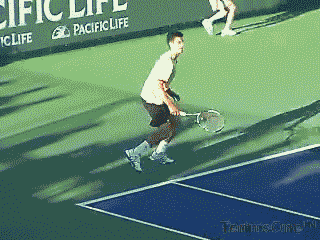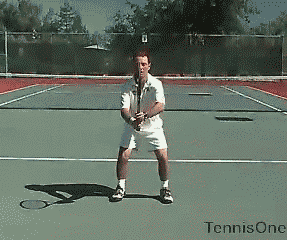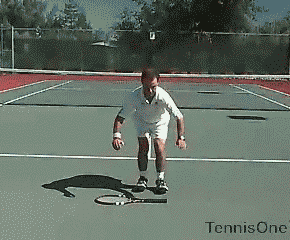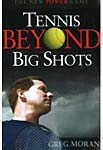| TennisOne Lessons The Most Important Move in Tennis Greg Moran While sound stokes, that will hold up under the pressure of an intense match, are certainly important, I've always felt that they're of little use if you can't get into position to execute them. We’ve all seen players who have beautiful technique during their lessons or in the warm-up only to have their games deteriorate into a mass of contortions and compensations once they actually have to move to the ball. “I play great during my lessons but horribly during matches,” is the cry of thousands of recreational players around the world.
Frustrated by their lack of improvement, these players are forever in search of the “new” grip or stroke that will miraculously catapult them to the next level. However, for many, the technical issue resides not with the way they hold or swing their racquet but rather the way they move, or don’t move, their feet. When all is said and done, tennis is much more of a “moving” game than it is a “hitting” game. By this I mean that your strokes are largely dictated by your bodies positioning to the ball. When the time comes to swing your racquet, you can only move your shoulders, hips and arms in a manner which your body, through proper (or improper) positioning will allow. If you’re well positioned and balanced, you’ll be able to execute that smooth, controlled stroke that seems so easy during your lessons. On the other hand, if you’re poorly positioned or off balance your stroke will likely breakdown. You’ll struggle to control your shot and potentially injure yourself. This is why I feel that, once a player has developed a solid foundation for the basics of the game, footwork becomes the most important element of tennis. It all Begins with the Feet The next time you’re at the club, pick a court and study the player’s feet for a few points. You’ll often see that they’re standing still, heels to the court, as their opponents strike the ball. Then, with a panicked look on their face, they take off in a mad dash. In their haste to get into position, they frequently overrun their mark. Then, with the ball literally on top of, or behind them, they wrap themselves up like a pretzel and fight to get the ball back over the net. If they’re fortunate enough to survive and actually keep the ball in play, they then enjoy a brief moment of relief before the next frantic sprint begins.
This means that, if you weight 150 pounds and are standing still, it’s as if you have a 150 pound weight resting on your head. When your opponent hits their shot, your first movement will not be a reaction to the ball, but rather to push that weight off your head. Only then, can you begin to move to the ball. This late start is what results in that mad scramble from shot to shot. Now, take a look at the pros or even the top players at your club. Shift your eyes downward, so that you're, again, focused solely on their feet. Aside from the fact that their feet are almost always in motion, you'll notice that, every now and then, they take a small hop up into the air. Then, with a lightening quick first step, they explode off in the direction of the ball, execute a smooth stroke and, as we so often hear, “make it look so easy.” This small hop is known as a split-step. In essence, the split-step pushes that 150 pound weight off your head, gives you the quickest possible start to the ball and is what often separates the true players from the pretenders. One (Split) Step to the Next Level As your opponent’s racquet begins to move forward towards the ball, bend your knees and take a short hop (no more than a few inches off the court). Time the hop so that you are in the air as the ball is struck. As you come down, and have determined which way the ball is traveling, touch down first with your outside foot (the foot furthest away from the oncoming ball). Then, with an explosive push, turn your body towards the ball and begin moving. For example, if you’re a right handed player and, during your split-step, you notice the ball coming to your forehand side, your left foot (outside) would touch down just before your right (inside) and then push you off towards the ball. This technique allows you to get the quickest first step towards the ball which, when all is said and done, is the key to successful footwork. The secret to a wining split-step lies in the timing. If you hop too soon, you'll be off balance when your opponent strikes their shot. If you’re late, you'll be slow reacting. Begin your hop just before your opponent makes contact with the ball. Though you may find the timing a bit difficult at first, keep working on it and, in a short while, you'll find that you're reacting significantly faster and feel as if you have all day to prepare for your shot. The next time you take the court, commit to taking a split step before every shot your opponent (or practice partner) hits. I like to have my students actually say the word "split" at the appropriate time to remind them to use the split step.
In addition to helping you get to the ball quicker, the split step will help you stay mentally alert as your opponent strikes the ball. This will help you anticipate their shot. I often find that when my feet get lazy, my mind wanders. When I remind myself to get up on my toes and take strong split-steps, my focus, and level of play, always improves. By the way, many players associate the split step only with an approach to the net. The truth is you should split step whether you are attacking the net, hitting ground strokes or returning serve and this is where fitness enters into the equation. Keri Blank, a Pat Etcheberry certified trainer in Connecticut says that, “during the course of a typical tennis match you’ll potentially hit hundreds and hundreds of balls. If you’re going to split step before every shot, not to mention move quickly and efficiently around the court, you’ll need to develop strong and flexible leg muscles.” Here are two exercises that Keri recommends to target the key quadriceps and calf muscles:
Active Squats: Grab your tennis racquet and assume the ready position: feet, shoulders width apart, knees slightly bent, and hold your racquet at approximately waist height. From that position, drop your knees until you feel tension come into your quads. Hold that position for a five count and then rise back up. Be sure to keep your back straight and make certain that your knees do not extend out over your feet. Repeat 10 times. Build up to three, sets of 15. Racquet Jumps: Place your racquet horizontally on the court in front of you. Stand behind the grip with your feet approximately 2-3 inches apart. Using your quads and then calves, bend down approximately 2-3 inches and hop over the racquet and then back, springing as you go. As you want to train your body for what it will face on the court, remember that the average tennis point lasts for less than ten seconds. So begin by doing 1, ten second, set of racquet jumps. As you get stronger, increase the number of sets that you do. Try these exercises, commit to mastering the split step and I guarantee that you'll notice a new spring in your step on the court. Plus, as you develop a quicker first step, I think you’ll find that your "beautiful" strokes will miraculously become easier to execute. Your comments are welcome. Let us know what you think about Greg Moran's article by emailing us here at TennisOne.
Tennis Beyond Big Shots presents a bold back-to-the-future approach. A new game that moves away from power and big shots yet is more lethal to opponents than any booming serve. Greg Moran shows players of all ages and abilities that, with simple and small changes, you can not only maximize your tennis wins and play longer, but also have much more fun doing it. Click link to purchase Greg Moran's book, Tennis Beyond Big Shots. |




